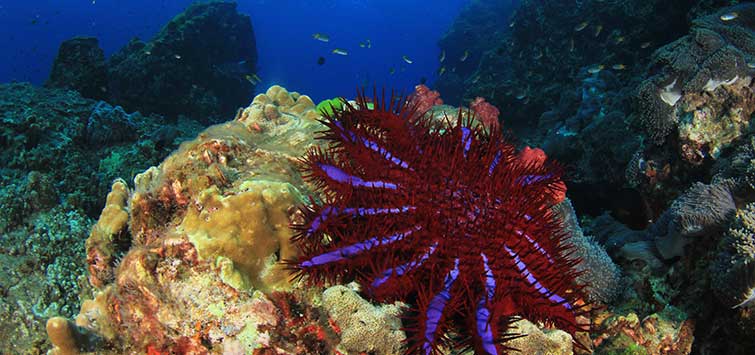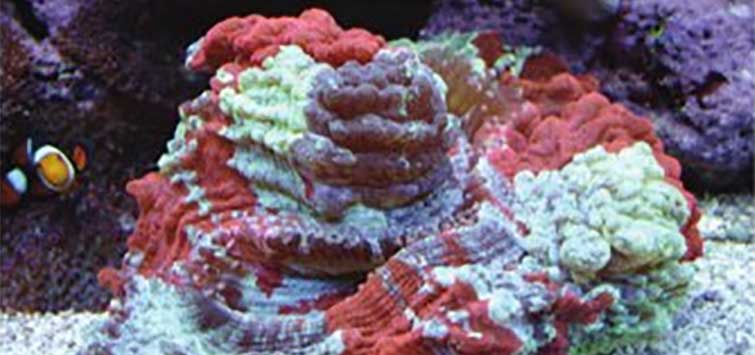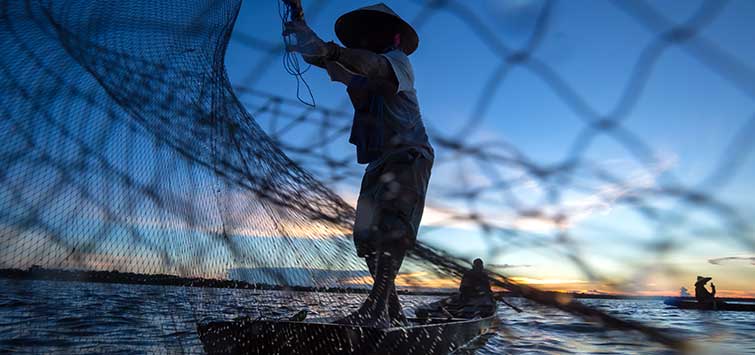Corals on the Front Lines
Author: Bill Rosser
Although aggression is typically witnessed between fishes, sessile invertebrates engage in some of the most deadly encounters on the reef.
Stuck in a Jam
Imagine that you are permanently stuck in one place, surrounded by predators that want to harm you, and have neighbors that want the space you occupy. How would you protect yourself? How would you secure food?
In a world of predators and competitors, where it is survival of the fittest, it should come as no surprise that many sessile invertebrates such as coral and other seemingly benign invertebrates have developed biological survival mechanisms.
Many fish, like butterflyfish and parrotfish, are corallivores: They feed heavily or exclusively on corals. Some corals produce a thick mucus that can be very distasteful to fish, while other inverts like anemones can have a very painful sting.
Fortifications to Survive
Acanthaster planci, better known as the crown-of-thorns starfish, have been observed marching across the ocean floor in huge army-like masses leaving coral graveyards riddled with skeletons. Even crown-of-thorns have armed themselves with venomous spines to ward off predators despite their strength in numbers, however. These spines can inject a powerful neurotoxin potent enough to cause severe pain, nausea, and vomiting in humans that can last for hours, as well as produce bruising at the sting site that can remain for weeks. Imagine the devastating effects that this venom would have on marine life, where an injured animal can rarely defend itself against predators.
But despite the crown-of-thorn’s strong defense, it still falls prey to the giant triton mollusk, the harlequin shrimp, and the humphead wrasse. In an ironic turn of fate, a large solitary coral polyp of the genus Pseudocorynactis is documented to feed on the crown-of-thorns starfish.
Protection from Other Corals
Not only do sessile invertebrates have to protect themselves from predators, they also need to keep other coral species from encroaching upon their own colonies. Despite the vastness of the oceans, prime real estate for the optimum growth of corals is rather limited, so competition is fierce.
Obtaining Food
Aside from being used in defense against predators and competition, these same mechanisms are essential for many corals to obtain food. While the majority of coral do receive nutrients from their symbiotic relationship with zooxanthellae, drifting sea fare is just as important to their survival. Not to mention, sessile inverts that are azooxanthellateare incapable of producing any of their own nutrients. Aposymbiotic corals, such as Tubastraea spp.,absolutely depend on their sweeper tentacles and nematocysts to secure a drifting meal.
Coral Defenses
Considering the many different species of corals and their physiological differences as well as their habitat preferences, it is no surprise that one species’ defenses are completely different from another.
Corals can react very aggressively. Many of the stony corals are capable of producing short to surprisingly long sweeper tentacles, while many of the soft corals produce a toxic, slimy mucus. Some soft corals have also been observed producing sweeper tentacles. Both of these mechanisms are very useful for securing and/or maintaining room for a species to grow. Not only are these adaptations used competitively, they also likely act as a predatory deterrent to other inverts and fish that would otherwise consume them.
Sweeper Tentacles
Sweeper tentacles are elongated tentacles equipped with cnidocytes (venomous cells) that serve two purposes: defense, and to secure food. Within the cnidocytes are the nematocysts, and these are what pack the punch. Their function is similar to that of a hypodermic needle or the stinger of a bee. The nematocysts, upon puncturing tissue with their harpoon-like tip, will inject toxins. Most stung corals may recede, shrink, fail to open, and even show signs of tissue necrosis in severe cases. Most prey items suffer paralysis, allowing them to be easily consumed.
While all corals have some type of defensive mechanism, some species are very dangerous to nearby competitive corals, and in some instances capable of delivering an excruciating sting to an adult human.
Galaxy Coral
Galaxy coral Galaxea spp. are commonly encountered in aquarium stores. A large colony of Galaxea is absolutely beautiful and jaw dropping even to someone who does not keep a reef aquarium. Beware, however; this species is a coral killer.
Galaxea are literally armed to their boney skeleton with immense numbers of long tentacles that can be sent out to deter an encroaching species’ growth. These tentacles can sometimes exceed 12 inches! Most of the time, the damage that these sweeper tentacles inflict can lead to lasting damage and tissue necrosis. The best way for the aquarist to combat the long sweeper tentacles of the galaxy coral is to place it in a portion of the aquarium where water current is reduced. The stronger the current, the easier the sweeper tentacles can stretch and drift.
Although not nearly as common as Galaxea, the fire corals of the genus Millepora do make their way to the aquarium from time to time. Fire coral have one of the most potent stings of all corals.
Mucus
On the opposite side of the spectrum are corals whose main defense is to produce, retain, or shed mucus depending on a number of factors. It should be noted that all coral produce mucus and mucus webs that can be dispersed into the water. Just like sweeper tentacles, mucus secretions serve toward defense and securing food.
Several corals belonging to the family Alcyoniidaealso require strategic placement in an aquarium with respect to their neighbors. Commonly known as colt, leather, finger, lobed, or cabbage coral, these animals are extremely popular with aquarists. Members of the genus Cladiella have been shown to be nontoxic, while the genera Lobophytum, Sinularia,and Sarcophyton are extremely toxic to stony corals in particular.
Toxicity
They may not have overly long sweeper tentacles, but what they lack in physical attributes is made up for in toxic attributes. These corals produce a powerful compound known as flexibilide and dihydroflexibilide, which are highly dangerous to some—if not all—species of Acropora and Porites. Lobophytum, Sinularia,and Sarcophyton are capable of secreting a thick, sticky mucus that oozes off the coral and releases into the water column to deliver their toxic compounds. As this mucus drifts around the aquarium, it can easily adhere to competitive corals.
These two specific compounds are primarily growth inhibitors with long-lasting effects that frequently result in death. Other compounds produced by other corals, regardless of their delivery system, may result in what can best be described as chemical burns. Every genus is different and produces its own toxins.
Polychaete feather dusters are also capable of producing a sticky mucus. Granted, this secretion is mainly used for collecting sediment to construct their tubular homes, but their secretions may still be capable of causing damage to some species of coral, especially stressed specimens.
Planning a Reef Aquarium
Remember, despite the dangers corals may pose to other species, they are completely harmless to their own kind. That doesn’t mean they can be crammed together without room to grow, however; space is still very important. What it does mean is that they won’t damage each other as they grow.
Sea anemones are also known to be very harmful toward other species, especially corals. Bubble anemones, carpet, sebae, and Condylactis anemones are all very common and sought after by novice and experienced aquarists. But be warned, not only do anemones have potent nematocysts, they are also surprisingly mobile and can wreak havoc on a reef tank in a very short time.
Along with a handful of preventative practices that one should be familiar with, there are also several basic layouts, or blueprints if you will, that can be helpful in maintaining peace in an aquarium.
Careful Communities
Community aquariums are the most common type of aquarium structure. The term “community” should be used cautiously, especially in regard to the behaviors of corals and their defenses. Caution should be exercised with mobile invertebrates and fish as well. This type of layout frequently gets newcomers to the reef hobby into trouble simply because of the word “community” itself. In reality, many marine fish are territorial at best, and corals can be hazardous to nearby corals. None of them will ever be friends, but they can coexist with proper care and planning.
In the Aquarium
Just because corals are constantly trying to oust their competition doesn’t mean they cannot ever live together in the confines of a home aquarium, however. Perhaps the most obvious way to reduce competition is to provide each specimen with adequate room to grow and expand. As a general rule of thumb, provide all corals with 6 inches of room to grow in every direction. More is better, especially for corals with long sweeper tentacles, such as Galaxea spp., but 6 inches is a good starting point.
In addition to providing adequate space, try to keep members of the same genus in the same part of the aquarium. In many cases, these corals will not harm each other. There are sure to be some exceptions, so always do your homework. Know what you are purchasing and the conditions the coral will require to thrive.
Filtration
Aggressive filtration is also very effective in keeping corals safe from one another. Foam fractionation or protein skimming is very efficient at removing mucus and toxins from the water. Carbon should be used in combination to aid in removing organics and will increase your system’s overall efficiency.
Water Movement and Toxins
Chaotic water movement is a magnificent way to prevent sweeper tentacles and toxin-ridden slime from settling in any one spot. This can either work for you or against you—it’s a double-edged sword. While the random currents in the aquarium may be capable of keeping slime from settling and tentacles from stretching in one direction, there is also the risk of that same chaotic water creating a current that allows one coral’s defenses to come into contact with another coral. Take care when determining which direction a powerhead or return will face.
Tank Size
In maintaining a healthy noncompetitive reef, the size of the aquarium can speak volumes as to the aquarist’s capabilities. Plain and simple, the larger the aquarium, the more corals one can safely accommodate.
Natural Barriers
Lastly, to aid in avoiding conflicts between growing corals, try to create natural barriers between them. Live rock is very effective in preventing sweeper tentacles from coming into contact with other corals. Rock barriers may also aid in deflecting water current that may be carrying shed mucus.
Species Tanks
Species-specific tanks or niche tanks are often looked upon as boring due to what the name implies: an aquarium that maintains only one species or a very limited number of species. Maintaining such an aquarium will remove the guesswork of coral compatibility, but that doesn’t mean the aquarium has to be boring. Many types of corals also provide niche habitats that are specific to certain fish and motile invertebrates. For example, an aquarium that strictly accommodates sebae anemones would provide a suitable (and natural) habitat for sebae clownfish, sexy shrimp, and porcelain crabs. Similarly, many species of gorgonians provide homes for gobies and sea stars.
Adding Fish
The decision to introduce fish into a reef aquarium may come with consequences as well. Coral are generally incapable of harming fish, but fire coral and giant cup mushrooms Amplexidiscus fenestrafer are exceptions. Fire coral have a debilitating sting, while elephant-ear mushrooms can rapidly close around small fish. On the other hand, many fish may nibble on corals.
Plan to Survive
In a world full of dangers, the best defense is a good offense. Just because these animals are in the confines of a seemingly peaceful aquarium does not mean that the corals can rest easy. They will always be competing to survive.
See the full article on TFH Digital http://www.tfhdigital.com/tfh/201109#pg95

.png?h=595&iar=0&w=2781&hash=5FD5E69473BCC22199FBFA2FB71B6033)



